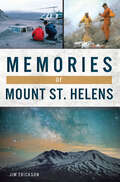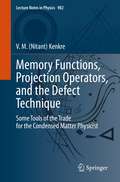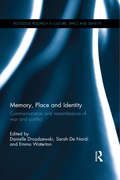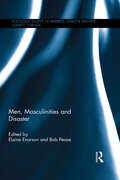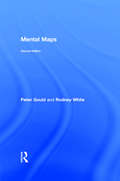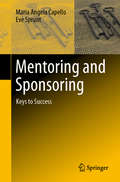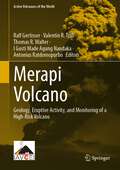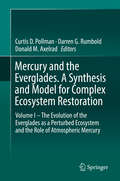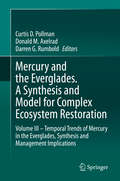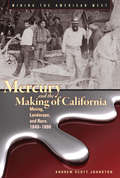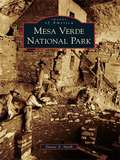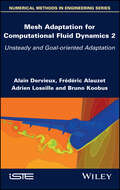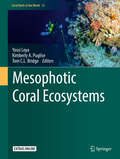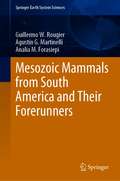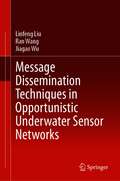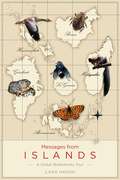- Table View
- List View
Memories of Mount St. Helens
by Jim Erickson&“Takes a local and regional perspective in looking back on the mountain&’s history, the frenzied days surrounding the eruption, and its aftermath.&” —The Oregonian In the spring of 1980, Mount St. Helens awoke from a century-long slumber with a series of dramatic changes. Most threatening was a bulge on the side of the snowy peak, pushing steadily outward. Near Spirit Lake, local resident Harry Truman refused to leave his lodge, even as scientists like David Johnston warned about potential destruction. On May 18, the mountain finally blew, enveloping whole communities in ash and smoke. Mudflows destroyed bridges, houses and highways, and fifty-seven people, including Truman and Johnston, lost their lives. Today, the mountain is quiet. Plants and animals have returned and hiking trails have been rebuilt, but the scars remain. Join author and journalist Jim Erickson as he recounts the unforgettable saga of the Mount St. Helens eruption.</
Memory Functions, Projection Operators, and the Defect Technique: Some Tools of the Trade for the Condensed Matter Physicist (Lecture Notes in Physics #982)
by V. M. KenkreThis book provides a graduate-level introduction to three powerful and closely related techniques in condensed matter physics: memory functions, projection operators, and the defect technique. Memory functions appear in the formalism of the generalized master equations that express the time evolution of probabilities via equations non-local in time, projection operators allow the extraction of parts of quantities, such as the diagonal parts of density matrices in statistical mechanics, and the defect technique allows solution of transport equations in which the translational invariance is broken in small regions, such as when crystals are doped with impurities. These three methods combined form an immensely useful toolkit for investigations in such disparate areas of physics as excitation in molecular crystals, sensitized luminescence, charge transport, non-equilibrium statistical physics, vibrational relaxation, granular materials, NMR, and even theoretical ecology. This book explains the three techniques and their interrelated nature, along with plenty of illustrative examples. Graduate students beginning to embark on a research project in condensed matter physics will find this book to be a most fruitful source of theoretical training.
Memory, Place and Identity: Commemoration and remembrance of war and conflict (Routledge Research in Culture, Space and Identity)
by Emma Waterton Danielle Drozdzewski Sarah De NardiThis book bridges theoretical gaps that exist between the meta-concepts of memory, place and identity by positioning its lens on the emplaced practices of commemoration and the remembrance of war and conflict. This book examines how diverse publics relate to their wartime histories through engagements with everyday collective memories, in differing places. Specifically addressing questions of place-making, displacement and identity, contributions shed new light on the processes of commemoration of war in everyday urban façades and within generations of families and national communities. Contributions seek to clarify how we connect with memories and places of war and conflict. The spatial and narrative manifestations of attempts to contextualise wartime memories of loss, trauma, conflict, victory and suffering are refracted through the roles played by emotion and identity construction in the shaping of post-war remembrances. This book offers a multidisciplinary perspective, with insights from history, memory studies, social psychology, cultural and urban geography, to contextualise memories of war and their ‘use’ by national governments, perpetrators, victims and in family histories.
Men, Masculinities and Disaster (Routledge Studies in Hazards, Disaster Risk and Climate Change)
by Bob Pease Elaine EnarsonIn the examination of gender as a driving force in disasters, too little attention has been paid to how women’s or men’s disaster experiences relate to the wider context of gender inequality, or how gender-just practice can help prevent disasters or address climate change at a structural level. With a foreword from Kenneth Hewitt, an afterword from Raewyn Connell and contributions from renowned international experts, this book helps address the gap. It explores disasters in diverse environmental, hazard, political and cultural contexts through original research and theoretical reflection, building on the under-utilized orientation of critical men’s studies. This body of thought, not previously applied in disaster contexts, explores how men gain, maintain and use power to assert control over women. Contributing authors examine the gender terrain of disasters 'through men's eyes,' considering how diverse forms of masculinities shape men’s efforts to respond to and recover from disasters and other climate challenges. The book highlights both the high costs paid by many men in disasters and the consequences of dominant masculinity practices for women and marginalized men. It concludes by examining how disaster risk can be reduced through men's diverse efforts to challenge hierarchies around gender, sexuality, disability, age and culture.
Mental Maps
by Peter Gould Rodney WhitePublished in the year 2004, Mental Maps is a valuable contribution to the field of Geography.
Mentoring and Sponsoring: Keys to Success
by Maria Angela Capello Eve SpruntThis book is a compilation of very personal approaches to mentoring and sponsoring, breaking the stereotypes of seniority, age or experience. The authors have provided a platform to understand that mentoring and especially sponsoring are in fact a win-win relation, in which both sides, mentors and mentees; and sponsors and sponsored individuals learn from each other, enhancing their career paths. How they managed to create a growth space for themselves and their teams through mentoring and sponsoring, is a story of professional leadership. They shared a privileged outlook to understand the root causes of barriers, as well as to envision plausible solutions for difficult career crossroads, in which mentorship or sponsoring was key to steer step changes.The authors propose not only their vision, but a remarkable collection of unfiltered interviews with young and renown professionals in many sectors, from photography to music, research, sports, energy, and more, completing a vision of what is key for both sides of the equation pertinent to mentoring and sponsoring: the givers and the receivers. They explain what is needed to gain the most out of the mentoring and sponsoring loops, with their own career stories.Success is supported by many factors, in which the most important are the technical competency and performance aligned with resilience. However, in the long path of a career, mentors and particularly sponsors play a foundational and frequently a changing-life role, improving our perspective or triggering reflections and actions that benefitted our journeys at work and in life.This book provides insights on what works for an effective mentoring and sponsoring process. It is useful for all professionals, especially those starting their career journeys.
Merapi Volcano: Geology, Eruptive Activity, and Monitoring of a High-Risk Volcano (Active Volcanoes of the World)
by Valentin R. Troll Ralf Gertisser Thomas R. Walter I Gusti Made Agung Nandaka Antonius RatdomopurboThis book provides the first comprehensive compilation of cutting-edge research on Merapi volcano on the island of Java, Indonesia, one of the most iconic volcanoes in the world. It integrates results from both the natural (geology, petrology, geochemistry, geophysics, physical volcanology) and social sciences, and provides state-of-the-art information on volcano monitoring, the assessment of volcanic hazards, and risk mitigation measures.As one of Indonesia’s most active and dangerous volcanoes, Merapi is perhaps best known for its pyroclastic density currents, which are produced by gravitational or explosive lava dome failures (commonly referred to as Merapi-type nuées ardentes). Merapi’s eruptions have posed a persistent threat to life, property and infrastructure within the densely populated areas on the volcano’s flanks, as demonstrated most recently by catastrophic eruptions, which attracted worldwide media interest.
Mercury Pollution in Minamata (SpringerBriefs in Environmental Science)
by Hisashi YokoyamaThis book is open access under a CC BY 4.0 license. It overviews the poisoning which occurred in the 1950s and 1960s among the residents in Minamata who ate seafood contaminated with methylmercury discharged from the chemical factory, Chisso Corporation. It describes the history, symptoms pathogenesis and research on the causal agent, and discusses the responses of Chisso and the national and local governments to the outbreak, the victims, the compensation and environmental restructuring as well as the court ruling on claims. Based on lecture notes from a university course, it includes students’ suggestions for avoiding a repeat of the tragedy. The issue has not been settled yet, and this analysis of the incident provides useful insights into solutions to the current global mercury pollution problem.
Mercury and the Everglades. A Synthesis and Model for Complex Ecosystem Restoration: Volume I – The Evolution of the Everglades as a Perturbed Ecosystem and the Role of Atmospheric Mercury
by Curtis D. Pollman Darren G. Rumbold Donald M. AxelradThis book integrates 30 years of mercury research on the Florida Everglades to inform scientists and policy makers. The Everglades is an iconic ecosystem by virtue of its expanse; diversity of biota; and multiple international designations. Despite this, the Everglades has been subjected to multiple threats including: habitat loss, hydrologic alterations, invasive species; and altered water quality. Less well recognized as a threat to Everglades human use and wildlife populations is the toxic metal, mercury. This Volume focuses on sources of mercury to the Everglades from the late-1980’s when there was bewilderment as to why there were very high levels of mercury in the Everglades food web. Soon came the finding that mercury loadings from atmospheric deposition accounted for over 95% of total input to the Everglades which resulted in Florida conducting the most comprehensive mercury monitoring and modeling study performed to date. Topics discussed in this Volume include: (1) Why atmospheric deposition fluxes of mercury to the Everglades are amongst the highest in the U.S; (2) That these are overwhelmingly from sources outside of the U.S; (3) That mitigation strategies for resolving the elevated food web mercury problem in the Everglades that rely solely on reducing atmospheric mercury inputs will not be effective for many decades; (4) That consideration of other strategies, in particular controlling factors related to Everglades mercury biogeochemical cycling seem warranted.
Mercury and the Everglades. A Synthesis and Model for Complex Ecosystem Restoration: Volume III – Temporal Trends of Mercury in the Everglades, Synthesis and Management Implications
by Curtis D. Pollman Darren G. Rumbold Donald M. AxelradThis book is the final installation in a three-volume series synthesizing 30 years of mercury research in the Florida Everglades. The first part of this book evaluates the occurrence of trends in both biota mercury concentrations and atmospheric mercury deposition. Through both empirical and deterministic analyses, the likely drivers of biota trends are identified. These analyses help lay the predicate for devising an overall strategy to mitigate and manage the Everglades mercury problem. The book concludes with a model analysis of the likely benefits and uncertainty attendant with implementing the leading candidate strategy for best reducing the Everglades mercury problem.
Mercury and the Making of California: Mining, Landscape, and Race, 1840–1890 (Mining the American West)
by Andrew Scott JohnstonMercury and the Making of California, Andrew Johnston’s multidisciplinary examination of the history and cultural landscapes of California’s mercury-mining industry, raises mercury to its rightful place alongside gold and silver in the development of the American West. Gold and silver could not be refined without mercury; therefore, its production and use were vital to securing power and wealth in the West. The first industrialized mining in California, mercury mining had its own particular organization, structure, and built environments. These were formed within the Spanish Empire, subsequently transformed by British imperial ambitions, and eventually manipulated by American bankers and investors. In California mercury mining also depended on a workforce differentiated by race and ethnicity. The landscapes of work and camp and the relations among the many groups involved in the industry—Mexicans, Chileans, Spanish, English, Irish, Cornish, American, and Chinese—form a crucial chapter in the complex history of race and ethnicity in the American West. This pioneering study explicates the mutual structuring of the built environments of the mercury-mining industry and the emergence of California’s ethnic communities. Combining rich documentary sources with a close examination of the existing physical landscape, Johnston explores both the detail of everyday work and life in the mines and the larger economic and social structures in which mercury mining was enmeshed, revealing the significance of mercury mining for Western history.
Mercy Under Fire: War And The Global Humanitarian Community
by Larry MinearFrom Bosnia to Somalia, and most recently from Rwanda to Angola and the Sudan, humanitarian aid and international interventions have gone awry. Although the need for humanitarian assistance has not diminished in the wake of the Cold War, success stories will almost certainly be harder to come by. This book addresses that grim prospect. Based on sch
Mesa Verde National Park
by Duane A. SmithMesa Verde National Park was America's first cultural park and also the world's first cultural heritage park. Created in 1906, it preserves the sites and materials of the prehistoric Puebloan people. Located in southwestern Colorado near the famous Four Corners, where the states of Colorado, Utah, Arizona, and New Mexico meet, the magnificent Mesa Verde is situated in Montezuma County, just south of Cortez and directly west of Durango. The park's rich archaeological history was played out amid some of the most ruggedly beautiful landscapes in the West. The greater story of the evolution of the park encompasses the Ute people, Theodore Roosevelt, novelist Willa Cather, and other personalities. These remarkable vintage photographs tell that saga, which is as fascinating as that of the Puebloans.
Mesh Adaptation for Computational Fluid Dynamics, Volume 1: Continuous Riemannian Metrics and Feature-based Adaptation
by Frederic Alauzet Adrien Loseille Alain Dervieux Bruno KoobusSimulation technology, and computational fluid dynamics (CFD) in particular, is essential in the search for solutions to the modern challenges faced by humanity. Revolutions in CFD over the last decade include the use of unstructured meshes, permitting the modeling of any 3D geometry. New frontiers point to mesh adaptation, allowing not only seamless meshing (for the engineer) but also simulation certification for safer products and risk prediction.Mesh Adaptation for Computational Dynamics 1 is the first of two volumes and introduces basic methods such as feature-based and multiscale adaptation for steady models. Also covered is the continuous Riemannian metrics formulation which models the optimally adapted mesh problem into a pure partial differential statement. A number of mesh adaptative methods are defined based on a particular feature of the simulation solution.This book will be useful to anybody interested in mesh adaptation pertaining to CFD, especially researchers, teachers and students.
Mesh Adaptation for Computational Fluid Dynamics, Volume 2: Unsteady and Goal-oriented Adaptation
by Frederic Alauzet Adrien Loseille Alain Dervieux Bruno KoobusSimulation technology, and computational fluid dynamics (CFD) in particular, is essential in the search for solutions to the modern challenges faced by humanity. Revolutions in CFD over the last decade include the use of unstructured meshes, permitting the modeling of any 3D geometry. New frontiers point to mesh adaptation, allowing not only seamless meshing (for the engineer) but also simulation certification for safer products and risk prediction.Mesh Adaptation for Computational Dynamics 2 is the second of two volumes and introduces topics including optimal control formulation, minimizing a goal function, and extending the steady algorithm to unsteady physics. Also covered are multi-rate strategies, steady inviscid flows in aeronautics and an extension to viscous flows.This book will be useful to anybody interested in mesh adaptation pertaining to CFD, especially researchers, teachers and students.
Meso-Neoproterozoic Geology and Petroleum Resources in China (Springer Geology)
by Tieguan WangThis book focuses on Meso- to Neoproterozoic geology and Petroleum resources in China. It offers the oldest sediments knowledge for petroleum generation, accumulation, alteration and preservation in the world. It provides a valuable contribution to the understanding of a potential Precambrian oil and gas exploration realm through well-developed Meso- to Neoproterozoic sedimentary strata with petroleum resources. This work will appeal to a wide readership, from geologists, geochemists, petroleum prospector, university faculty members to advanced students working for Precambrian and petroleum geological and geochemical research.
Mesophotic Coral Ecosystems (Coral Reefs of the World #12)
by Yossi Loya Kimberly A. Puglise Tom C.L. BridgeThis book summarizes what is known about mesophotic coral ecosystems (MCEs) geographically and by major taxa. MCEs are characterized by light-dependent corals and associated communities typically found at depths ranging from 30-40 m. and extending to over 150 m. in tropical and subtropical ecosystems. They are populated with organisms typically associated with shallow coral reefs, such as macroalgae, corals, sponges, and fishes, as well as specialist species unique to mesophotic depths. During the past decade, there has been an increasing scientific and management interest in MCEs expressed by the exponential increase in the number of publications studying this unique environment. Despite their close proximity to well-studied shallow reefs, and the growing evidence of their importance, our scientific knowledge of MCEs is still in its early stages. The topics covered in the book include: regional variation in MCEs; similarities and differences between mesophotic and shallow reef taxa, biotic and abiotic conditions, biodiversity, ecology, geomorphology, and geology; potential connectivity between MCEs and shallow reefs; MCE disturbances, conservation, and management challenges; and new technologies, key research questions/knowledge gaps, priorities, and future directions in MCE research.
Mesoscale Analysis of Hydraulics
by Weilin XuThis open access book presents a series of complicated hydraulic phenomena and related mechanism of high-speed flows in head-head dam. According to the basic hydraulic theory, detailed experiments and numerical simulations, microscopic scale analysis on cavitation bubbles, air bubbles, turbulent eddy vortices and sand grains are examined systemically. These investigations on microscopic fluid mechanics, including cavitation erosion, aeration protection, air–water flow, energy dissipation and river-bed scouring, allow a deep understanding of hydraulics in high-head dams. This book provides reference for designers and researchers in hydraulic engineering, environment engineering and fluid mechanics.
Mesoscale Meteorology in Midlatitudes
by Yvette Richardson Paul MarkowskiMesoscale Meteorology in Mid-Latitudes presents the dynamics of mesoscale meteorological phenomena in a highly accessible, student-friendly manner. The book's clear mathematical treatments are complemented by high-quality photographs and illustrations. Comprehensive coverage of subjects including boundary layer mesoscale phenomena, orographic phenomena and deep convection is brought together with the latest developments in the field to provide an invaluable resource for mesoscale meteorology students.Mesoscale Meteorology in Mid-Latitudes functions as a comprehensive, easy-to-use undergraduate textbook while also providing a useful reference for graduate students, research scientists and weather industry professionals.Illustrated in full colour throughout Covers the latest developments and research in the field Comprehensive coverage of deep convection and its initiation Uses real life examples of phenomena taken from broad geographical areas to demonstrate the practical aspects of the science
Mesoscale-Convective Processes in the Atmosphere
by Robert J. TrappThis new textbook seeks to promote a deep yet accessible understanding of mesoscale-convective processes in the atmosphere. Mesoscale-convective processes are commonly manifested in the form of thunderstorms, which are fast evolving, inherently hazardous, and can assume a broad range of sizes and severity. Modern explanations of the convective-storm dynamics, and of the related development of tornadoes, damaging "straight-line" winds, and heavy rainfall, are provided. Students and weather professionals will benefit especially from unique chapters devoted to observations and measurements of mesoscale phenomena, mesoscale prediction and predictability, and dynamical feedbacks between mesoscale-convective processes and larger-scale motions.
Mesoscopic Route to Time Travel
by Prosenjit Singha DeoThis book gives a general introduction to theoretically understand thermodynamic properties and response to applied fields of mesoscopic systems that closely relate to experiments. The book clarifies many conceptual and practical problems associated with the Larmor clock and thus makes it a viable approach to study these properties. The book is written pedagogically so that a graduate or undergraduate student can follow it. This book also opens up new research areas related to the unification of classical and quantum theories and the meaning of time. It provides a scientific mechanism for time travel which is of immense fascination to science as well as society. It is known that developments in mesoscopic physics can lead to downscaling of device sizes. So, new or experienced researchers can have a quick introduction to various areas in which they might contribute in the future. This book is expected to be a valuable addition to the subject of mesoscopic physics.
Mesozoic Mammals from South America and Their Forerunners (Springer Earth System Sciences)
by Analía M. Forasiepi Guillermo W. Rougier Agustín G. MartinelliThis book summarizes the most relevant published paleontological information, supplemented by our own original work, on the record of Mesozoic mammals’ evolution, their close ancestors and their immediate descendants. Mammals evolved in a systematically diverse world, amidst a dynamic geography that is at the root of the 6,500 species living today. Fossils of Mesozoic mammals, while rare and often incomplete, are key to understanding how mammals have evolved over more than 200 million years. Mesozoic mammals and their close relatives occur in a few dozen localities from Argentina, Brazil, Chile, Bolivia, and Peru spanning from the Mid- Triassic to the Late Cretaceous, with some lineages surviving the cataclysmic end of the Cretaceous period, into the Cenozoic of Argentina. There are roughly 25 recognized mammalian species distributed in several distinctive lineages, including australosphenidans, multituberculates, gondwanatherians, eutriconodonts, amphilestids and dryolestoids, among others. With its focus on diversity, systematics, phylogeny, and their impact on the evolution of mammals, there is no similar book currently available.
Mesozoic Stratigraphy of India: A Multi-Proxy Approach (Society of Earth Scientists Series)
by Santanu Banerjee Subir SarkarThis book envisages a multi-proxy approach using stable isotopes, geochemical proxies, magnetic susceptibility and associated biotic events for paleoclimatic and paleoenvironmental interpretations of the Mesozoic sedimentary record of India. Mesozoic rocks of India record abnormal sea level rise, greenhouse climate, intensified volcanism, hypoxia in seawater, extensive black shale deposition, and hydrocarbon occurrence. The Mesozoic has also witnessed mass extinction events, evolution of dinosaurs, and breakdown of the supercontinent Pangea and the formation of Gondwana. Although the Mesozoic geology of India has witnessed significant progress in the last century, literature survey reveals a huge gap in knowledge regarding sequence stratigraphy, chemostratigraphy and key geological events. A synthesis of sedimentological, paleontological and chemical data is included to presenting a comprehensive understanding of the Indian Mesozoic record to students, researchers and professionals.
Message Dissemination Techniques in Opportunistic Underwater Sensor Networks
by Ran Wang Linfeng Liu Jiagao WuThis book investigates the architectures and characteristics of OUSNs, the mobility models of OUSN nodes, the challenges of message dissemination, and some evaluation indexes of message dissemination. Then, this book provides some message dissemination techniques in OUSNs from the viewpoints of nodes and data messages, respectively. The proposed message dissemination techniques and their conclusions can provide some useful insights to improve the performance of data message dissemination and promote the future applications of OUSNs. Researchers and engineers in the field of underwater sensor networks can benefit from the book.
Messages from Islands: A Global Biodiversity Tour
by Ilkka HanskiFrom a small island in the Baltic Sea to the large tropical islands of Borneo and Madagascar, Messages from Islands is a global tour of these natural, water-bound laboratories. In this career-spanning work, Ilkka Hanski draws upon the many islands on which he performed fieldwork to convey key themes in ecology. By exploring the islands’ biodiversity as an introduction to general issues, Hanski helps us to learn how species and communities interact in fragmented landscapes, how evolution generates biodiversity, and how this biodiversity is maintained over time. Beginning each chapter on a particular island, Hanski dives into reflections on his own field studies before going on to pursue a variety of ecological questions, including: What is the biodiversity crisis? What are extinction thresholds and extinction debts? What can the biodiversity hypothesis tell us about rapidly increasing allergies, asthma, and other chronic inflammatory disorders? The world’s largest island, Greenland, for instance, is the starting point for a journey into the benefits that humankind acquires from biodiversity, including the staggering biodiversity of microbes in the ecosystems that are closest to us—the ecosystems in our guts, in our respiratory tracts, and under our skin. Conceptually oriented but grounded in an adventurous personal narrative, Messages from Islands is a landmark work that lifts the natural mysteries of islands from the sea, bringing to light the thrilling complexities and connections of ecosystems worldwide.
